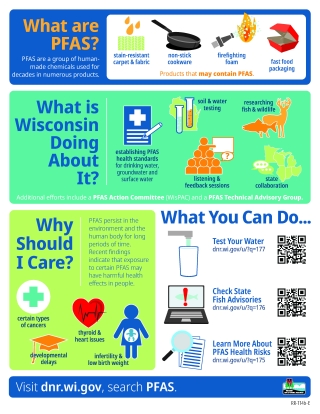Surface Water and Fish Tissue PFAS Sampling
Water Quality PFAS Initiatives
The DNR's Water Quality Program, in cooperation with the Fisheries Management Program and other partners, is conducting a multi-year, statewide monitoring project to sample fish tissue and water chemistry at select sites around the state near known or probable sources of PFAS. These sampling efforts will help develop a baseline of PFAS contamination within the state, help to identify action areas and provide the necessary data for appropriate responses. This is part of a broader effort to evaluate the health of our state's waterways and lakes.
Objectives
The three main objectives of this monitoring effort are:
- Describe PFAS concentrations in main exposure routes at sites with known or suspected contamination with comparability among sites.
- Characterize background conditions in major waterbodies.
- Collect paired fish tissue and surface water chemistry for statewide PFAS monitoring as part of water quality PFAS initiatives.
Objective 1: Investigate Sites With Elevated PFAS Concentrations
In 2019, DNR collected water chemistry and fish tissue samples from river systems in areas near known or suspected PFAS contamination sites, specifically Starkweather Creek, Wisconsin River, Silver and Suukjak Sup Creek, Mississippi River, Menominee and Peshtigo Rivers, and St. Louis River. The sites represented fire suppression training grounds; water wells where PFAS had previously been detected; and two locations where elevated fish tissue levels had previously been found.
In 2020, we expanded monitoring to include additional locations, as well as to follow up on 2019 results (e.g., Fort McCoy area, Philips, Black Earth Creek and the Yahara River and chain of lakes). In 2021, additional samples are being taken on the Yahara River, Badfish Creek, Wisconsin River, Lake Superior and Black River (French Island area) and will be posted when available. In most cases, samples were collected both upstream and downstream from known or suspected contaminated sites.
Objective 2: Assess Background PFAS Concentrations
In 2020, DNR collected water samples from 44 "Long-term Trend" sites, which are located on major river systems and whose water quality are routinely sampled each year. These sites are purposefully selected to capture different geographic regions and the watersheds in this monitoring network collectively cover approximately 80% of the state. The DNR also collected fish and water samples from 8 inland lakes in order to analyze patterns of PFAS accumulation (see Objective 3 below).
In general, PFOS and PFOA were often non-detectable (37% and 19% of sites respectively), and when detectable PFOS concentrations were < 5.0 ng/L (1.4 ng/L average) for all sites and < 10 ng/L (2.2 ng/L average) for PFOA. Geographic areas that showed higher relative PFAS concentrations were the Wisconsin and Mississippi Rivers and the Southeastern part of the state, whereas the Northwestern rivers were relatively lower, or non-detectable.
Objective 3: Collect Samples For Standard Development
The Water Quality Program is entrusted with establishing water quality standards through administrative rulemaking to protect public health and the environment. Paired fish and water samples that were collected from 25 Wisconsin waterways as part of Objectives 1 and 2 were combined with fish and water data from 24 Minnesota waterways in order to assess patterns of PFOS accumulation in fish. This information is helping DNR develop water quality standards that will protect human health from the health effects of exposure to PFOS through fish consumption.
Results from this effort are still being analyzed and will be released as part of the water quality standards rule package.
Visit the PFAS Surface Water Criteria page to find more information on the status of our rulemaking efforts.
Results and Reports
The DNR plans to summarize all tissue and water sample results in a comprehensive report in late 2021/early 2022.
Detailed information and results are available in the following reports. Additional reports will be added to this page as we finalize our analyses.
- Printable version of 2019 study results (with all 36 compounds for PFAS in water and fish)
- 2020 Madison Chain of Lakes PFOS/PFOA Sampling Results
- Map and Data: PFOS and PFOA Sampling Results at Long Term Trend Sites in Wisconsin (2020)
Interactive Map
Locations of state-wide PFAS monitoring sites and preliminary PFOS and PFOA results are viewable in the interactive map below.
Note: This map does not display the locations or results of fish tissue data being collected by the Fisheries Management Program, nor does it include fish consumption advisories based on PFOS. Consumption advisory information can be found on the following pages:
Disclaimer: Results are subject to change or update based on the most recent lab results.

